The East Hubei Tourist Zone includes Wuhan, Huanggang, Huangshi and Ezhou, centered on human landscapes. Noted scenic spots cover the Yellow Crane Tower, Provincial Museum, Guiyuan Temple. Mineral Relics of Tongiu Hill, Red Crag of Dongpo and hometown of eminent persons. The mountain scenery, East Lake, the scenery of Liangzi Lake, the massif of Mt Dabie are also attractive.
Yellow Crane Tower: Standing on the top of the Snake Hill, the Yellow Crane
Tower was built in 223 and rebuilt according to the Oing
Dynasty blueprint in 1985. The tower acquires the name
because Cui Hao, a Tang Dynasty poet, wrote a poem en-
titled "Yellow Crane Tower". The Yellow Crane Tower,
Yuyang Tower and Tengwang Tower are collectively rated
as the three noted towers in China.
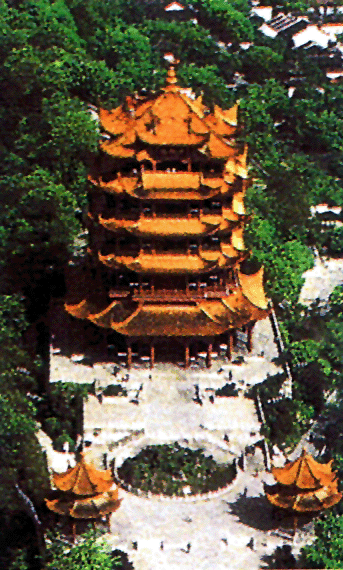
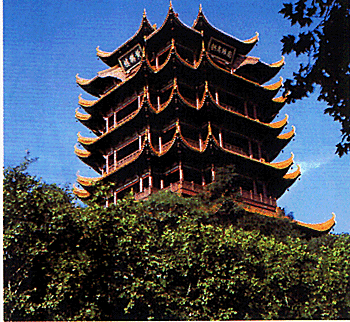
Museum of Hubei Province:The museum in Wuchang is a major storage, publicity and research institution for cultural relics and specimen in the province. Stored in the museum are over 200,000 objects, most of them being rare gems in the world. Ancient Chinese musical instruments are on display. Chimes owned by Marquis Yi of the State of Zeng are rated as the superb one in the world.
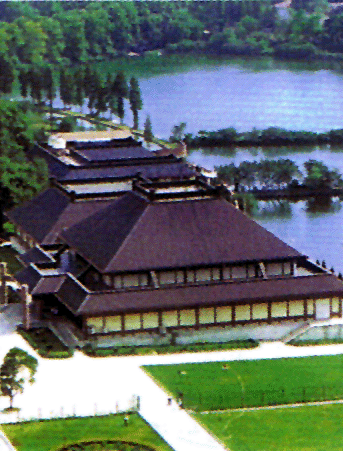
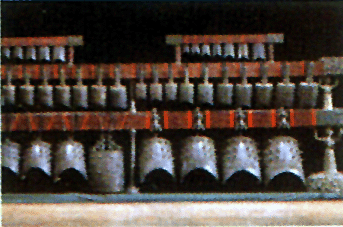
Wuhan Yangtze River Bridge: Located between the Snake Hill in Wuchang and Turtle Hill in Hanyang, the bridge, the first one built on the Yangtze River, was open to traffic in October 1957. This bridge, two other bridges on the Yangtze and five bridges on the Hanjiang River have enabled Wuhan to enjoy the reputation of being the "bridge city".
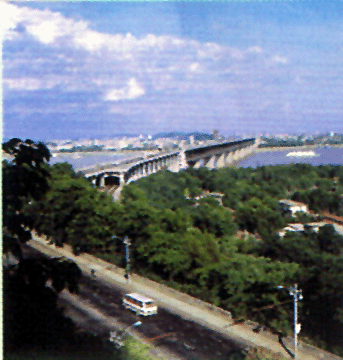
East Lake: The East Lake on the eastern suburb of Wuchang is the biggest lake in Wuhan. The lake is divided into Listening to the Wave, White Horse, Falling Wild Goose, Moshan Hill, Luohong and Flute Playing areas. Qu Yuan, an outstanding founder of the Chu culture, once recited poems on the shore. A special Chu culture tourist area has been constructed there. The Listening to the Wave tourist area on the western shore of the lake is centered on water landscapes. Major scenic spots include the water and the sky that merge into one color, Fable Sculpture Garden and Poem-chanting Pavilion.
The Moshan Hill tourist area on the eastern shore of the lake is centered on man-made landscapes. Its main scenic spots feature Vermilion Stele Pavilion and the Willow- Tree Garden. 
Guiyuan Temple: Located at the western end of Cuiwei Road in Hanyang, the temple built in 1864 is composed of viharas containing Buddhist sutras, the Grand Buddha Hall and the Arhat Hall. Collected in the viharas are white jade images of Buddha, over 7,000-volumes of Buddhist scriptures and scriptures in Indian, Sri Lanka, Myanmar, Thai and Japanese languages
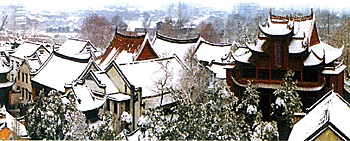
The hall with 500 Arhats is noted in China. These arhats wear different facial expressions, vividly depicting their personalities.
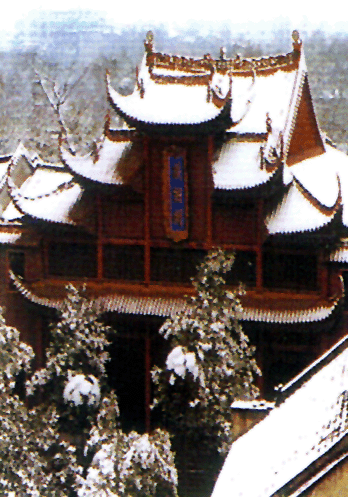
Qinghuan Pavilion: Situated at the eastern foot of the Turtle Hill, the pavilion faces the Yellow Crane Tower across the Yangtze River Built in the Ming dynasty, it has enjoyed the reputation of being the "First Tower of the Chu State". The pavilion was rebuilt in 1983 according to the Qing Dynasty blueprint. In the Oingchuan Pavilion Tourist area are the Iron Gate Pass, Mist-covered Stones. Eight Immortals Gully and Taizhen Kiosk.
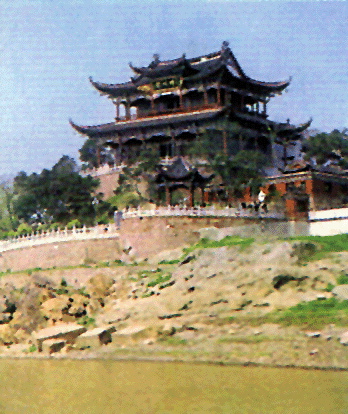
Ancient Fiddle Platform: Located on the shore of the Yuehu Lake in Hanyang, the Ancient Fiddle Platform was built in the Northern Song Dynasty in memory of friendship between Yu Boya and Zhong Ziqi. The gallery of the ancient palace hall and a square stone table are also built. Buildings in ancient styles and beautiful scenes benefit by associating together with the Yuehu Lake.
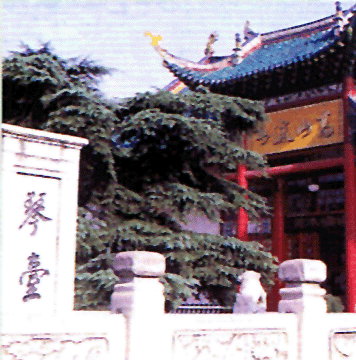
The hill with an elevation of 600 meters located at Taer township, north of Wuhan is reputed for its beautiful natural scenery and many temples of Buddhism. It is also known for the tale that beautiful Mulan took service for her father. Near the Mulan Hill are the Mulan Lake and Mulan River. The Mulan Lake migrant birds can be rated as a superb scene. Mulan Hill has attracted a large number of Taoist and Bud- dhist worshippers.
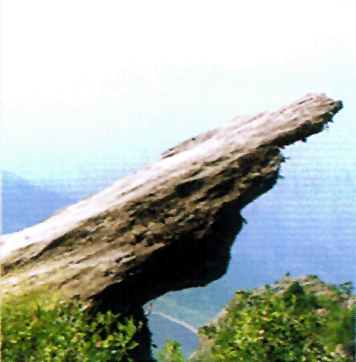
The Red Crag is located on the Red Crag Rock 38 km northwest of Chibi on the right shore of the Yangtze River. Built in the area are Yijiang and Wangjiang pavilions, Zhou Yu's stone statue, the exhibition hall of the Red Crag Battle, Temple of Zhuge Liang and other ancient relics.
The Red Crag battle occupies an important place in the history of the Three Kingdoms, while the ancient battle site is the only way which must be passed by visitors for their Three Kingdoms tour. 
Lushui Lake: The Lushui Lake on the southern side of Yanhu Road in Chibi has become a man-made lake, resulting from resisting the land water. Its features are that peaks rise one above the other in the distance, the water is as clear as crystal and the ecological environment is well protected Holidaymakers can ascend Xiantai and Gexian Ancestral temples to have a taste of the folk culture.
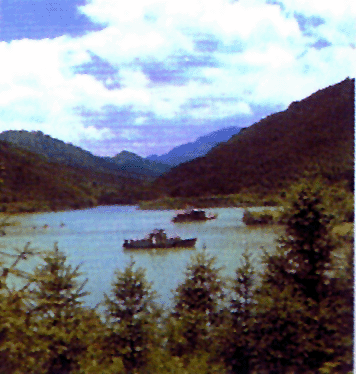
Jiugong Hill is near the Jiugongshan town in southern Hubei. Its grotesque peaks, crisscross, deep and secluded valleys and pouring springs have merged gorgeousness, queerness, beauty and dangers into an organic whole. Noted scenic spots include Shilong Gully, Cherry Gully Ecological Tourist Area, Yunzhong Lake and impregnable passes of the Wu and Chu states.

The Red Crag of Dongpu on the Red Crag Rock in Huanggang acquires its name because Su Dongpo once recited his poems there. When Su Dongpo was demoted to Huangzhou, he toured the place, mistook it for the Zhoulang Red Crag of the Three Kingdoms" and wrote the poem.
The place has since then been linked with the name of Su Dongpo To distinguish it from Zhoulang Red Crag, the place is called the Red Crag of Dongpu. In the scenic spot are the Scissors Peak. White Stone Turtle. Dongpo Exhibition Hall. Su Shi's Statue. Xixia Tower and Poxian Pavilion.
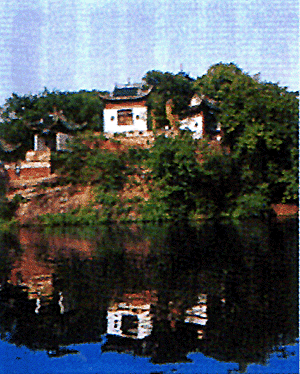
Dabieshan Forest Pack: The park in the north of Luotian County is known for the Zhongshan piedmont topography and the primitive forest scenery. It is a state forest park merging folk customs, agri- cultural landscape, and historic and human landscapes into an organic whole. The park is divided into five tourist areas.
The Badaofeng Tourist area is located west of Tiantangzhi, the main peak of Mt Dabie. It acquires the name because it towers into the clouds and its palisades are precipitous, looking like a thin knife. In the area are forests in great abundance and the charming scenery, curious rocks and grotesque peaks in particular.

|





















